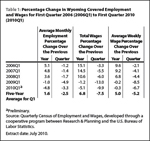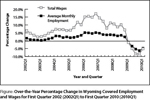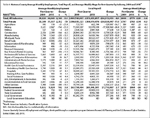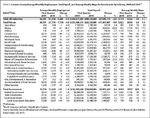Covered Employment and Wages for First Quarter 2010: Net Job Losses Slow *
Although net job losses were large and widespread in first quarter 2010, they were smaller than in the final two quarters of 2009, perhaps suggesting Wyoming's economy was beginning to stabilize.
From first quarter 2009 to first quarter 2010, total unemployment insurance (UI) covered payroll for Wyoming decreased by $139.8 million (-5.1%). UI covered payroll represents approximately 92% of all wage and salary disbursements and 45% of personal income in the state (U.S. Bureau of Economic Analysis, 2007). Table 1 shows that employment,  payroll, and average weekly wage grew at rates substantially lower than their five-year averages. However, job losses and declines in total payroll in first quarter were smaller than in the previous two quarters, perhaps suggesting Wyoming's economy was beginning to stabilize. Total payroll is an important economic indicator because it is often associated with consumer spending, retail sales, and sales tax revenue (Black & Evans, 1997).
payroll, and average weekly wage grew at rates substantially lower than their five-year averages. However, job losses and declines in total payroll in first quarter were smaller than in the previous two quarters, perhaps suggesting Wyoming's economy was beginning to stabilize. Total payroll is an important economic indicator because it is often associated with consumer spending, retail sales, and sales tax revenue (Black & Evans, 1997).
The covered payroll and employment data in this article are measured by place of work, in contrast to the labor force estimates, which are measures of employed and unemployed persons by place of residence. Also, the employment data presented in this article represent a count of jobs, not persons. When an individual works more than one job, each is counted separately. Finally, job growth (or decline) is stated in terms of net change. The Quarterly Turnover Statistics by Industry table presents alternative measures of job gains and losses.
The purpose of this article is to show employment and payroll changes between first quarter 2009 and first quarter 2010. These economic changes help gauge the overall strength of Wyoming's economy and identify the fastest and slowest growing sectors and geographic areas.
The Figure shows that job losses were smaller in first quarter 2010 than  in the third and fourth quarters of 2009. Declines in total payroll also moderated somewhat from -8.4% in third and fourth quarters to -5.1% in first quarter (see Table 2).
in the third and fourth quarters of 2009. Declines in total payroll also moderated somewhat from -8.4% in third and fourth quarters to -5.1% in first quarter (see Table 2). 
Employment and Wages by County
Table 3 shows that employment and wages decreased in most areas of the state. Three of the six counties where employment increased were located in the southeast region of the state while most oil & gas dependent counties saw substantial job losses.
Goshen County added 180 jobs (4.2%) and its total payroll grew by $2.6 million (8.8%). Job gains in state government (nearly 300 jobs), health care & social assistance (approximately 50 jobs), and local government (approximately 50 jobs) were partially offset by job losses in construction (more than 150 jobs).
Employment in Platte County increased by 91 jobs (2.8%) and its total payroll grew by $1.7 million (6.5%). Small job gains were seen in health care & social assistance, local government, and accommodation & food services.
Converse County added 84 jobs (1.6%) and its total payroll increased by $0.9 million (1.8%). Employment increased modestly in construction, local government, and mining.
Hot Springs County gained 25 jobs (1.2%) and its total payroll grew by $0.6 million (4.3%). Small job increases in mining (including oil & gas), retail trade, and local government were partially offset by job losses in construction.
Niobrara County added 24 jobs (2.9%) and its total payroll increased by $190,032 (3.2%). Modest job gains were seen in other services, local government, and accommodation & food services.
Big Horn County's employment increased by one job (0.0%) and its total payroll was essentially unchanged also (-$1,275, or 0.0%). Job losses in mining were mostly offset by job gains in manufacturing, professional & technical services, and health care & social assistance.
Sweetwater County lost 2,443 jobs (-9.8%) and its total payroll fell by $30.1 million (-9.8%). Mining (including oil & gas) posted the largest job losses (approximately 1,000 jobs), followed by accommodation & food services (approximately 400 jobs), construction (approximately 300 jobs), transportation & warehousing (approximately 250 jobs), and retail trade (approximately 200 jobs).
Campbell County's employment fell by 1,726 jobs (-5.9%) and its total payroll decreased by $4.4 million (-1.2%). Notable job losses were seen in mining (including oil & gas; approximately 500 jobs), construction (approximately 500 jobs), and administrative & waste services (more than 250 jobs).
Teton County lost 1,032 jobs (-6.1%) and its total payroll fell by $17.5 million (-10.8%). Employment decreased by approximately 550 jobs in construction, 100 jobs in accommodation & food services, and 100 jobs in retail trade.
Uinta County's employment fell by 768 jobs (-8.0%) and its total payroll decreased by $8.8 million (-8.8%). Mining (including oil & gas) posted the largest job losses (more than 150 jobs) followed by accommodation & food services (more than 100 jobs), construction (more than 100 jobs), and retail trade (more than 100 jobs).
Sheridan County lost 663 jobs (-5.0%) and its total payroll fell by $7.7 million (-6.6%). Substantial employment decreases were seen in construction (more than 100 jobs), retail trade (more than 100 jobs), and mining (approximately 100 jobs). Smaller job losses occurred in health care & social assistance, professional & technical services, and manufacturing.
Employment fell by 600 jobs (-3.9%) in Albany County and total payroll decreased by $0.9 million (-0.7%). Construction posted the largest job losses (more than 150 jobs), followed by professional & technical services (more than 100 jobs), administrative & waste services (approximately 100 jobs), and state government (approximately 100 jobs).
Table 4 shows that Natrona County lost 2,160 jobs (-5.5%) and its total  payroll decreased by $36.3 million (-8.9%). Mining (including oil & gas) posted the largest job losses (-764 jobs, or -21.0%) followed by other services (-380 jobs, or -19.1%), wholesale trade (-318 jobs, or -12.2%), retail trade (-256 jobs, or -5.1%), and manufacturing (-235 jobs, or -13.1%). Employment increased substantially in health care & social assistance (209 jobs, or 3.9%), federal government (102 jobs, or 15.7%), and local government (including public schools and colleges; 90 jobs, or 2.1%).
payroll decreased by $36.3 million (-8.9%). Mining (including oil & gas) posted the largest job losses (-764 jobs, or -21.0%) followed by other services (-380 jobs, or -19.1%), wholesale trade (-318 jobs, or -12.2%), retail trade (-256 jobs, or -5.1%), and manufacturing (-235 jobs, or -13.1%). Employment increased substantially in health care & social assistance (209 jobs, or 3.9%), federal government (102 jobs, or 15.7%), and local government (including public schools and colleges; 90 jobs, or 2.1%).
Laramie County's employment fell by 1,289 jobs (-3.0%) and its total  payroll decreased by $7.9 million (-2.0%; see Table 5). The largest job losses were found in accommodation & food services (-254 jobs, or -6.2%), construction (-189 jobs, or -7.2%), and retail trade (-161 jobs, or -3.1%). Slightly smaller job losses occurred in state government (-112 jobs, or -2.7%), transportation & warehousing (-99 jobs, or -4.5%), and manufacturing (-91 jobs, or -6.1%).
payroll decreased by $7.9 million (-2.0%; see Table 5). The largest job losses were found in accommodation & food services (-254 jobs, or -6.2%), construction (-189 jobs, or -7.2%), and retail trade (-161 jobs, or -3.1%). Slightly smaller job losses occurred in state government (-112 jobs, or -2.7%), transportation & warehousing (-99 jobs, or -4.5%), and manufacturing (-91 jobs, or -6.1%).
Statewide Employment and Wages by Industry
Table 6 shows that large job losses continued in mining  (including oil & gas), construction, retail trade, and accommodation & food services. Employment increased in local government, health care & social assistance, and federal government.
(including oil & gas), construction, retail trade, and accommodation & food services. Employment increased in local government, health care & social assistance, and federal government.
Mining employment continued to decline in first quarter. Employment decreased by 4,114 jobs (-14.6%) and total payroll fell by $60.0 million (-11.1%). Support activities for mining lost nearly 3,800 jobs and mining, except oil & gas lost more than 300 jobs.
Employment in Wyoming's construction sector decreased by 2,649 jobs (-11.9%) and its total payroll fell by $33.6 million (-13.7%). Specialty trade contractors lost more than 1,100 jobs, construction of buildings lost nearly 900 jobs, and heavy & civil engineering construction lost more than 600 jobs.
Retail trade employment fell by 1,594 jobs (-5.3%) and its total payroll decreased by $13.5 million (-7.4%). General merchandise stores (including warehouse clubs and supercenters) lost nearly 400 jobs, gasoline stations lost approximately 300 jobs, motor vehicle & parts dealers lost nearly 300 jobs, and miscellaneous store retailers lost more than 150 jobs.
Accommodation & food services lost 1,457 jobs (-5.1%) and its total payroll fell by $6.3 million (-5.6%). Employment in accommodation decreased by more than 600 jobs and employment in food services & drinking places decreased by approximately 800 jobs.
Local government added 1,021 jobs (2.3%) and its total payroll increased by $11.2 million (2.7%). Local government education (including public schools & colleges) added 789 jobs (3.4%), while employment at public hospitals decreased by 50 jobs (-0.8%). Public administration (including cities, towns, and counties) gained approximately 100 jobs.
Health care & social assistance grew by 378 jobs (1.7%) and its total payroll increased by $3.4 million (1.7%). Ambulatory health care services (including doctor's offices) gained 293 jobs (3.6%) and social assistance gained 135 jobs (2.1%). Employment held steady in private hospitals and decreased in nursing & residential care facilities (-52 jobs, or -1.1%).
Federal government added 298 jobs (4.2%) and its total payroll grew by $4.4 million (4.6%). Administration of economic programs (including the Census Bureau) added more than 300 jobs, while employment decreased at the postal service.
Although job losses were large and widespread in first quarter 2010, they were smaller than in the final two quarters of 2009, perhaps suggesting Wyoming's economy was beginning to stabilize.
References
Black, D. & Evans, M. (1997, May). Work, pay and consumer spending, part one: Sales tax collections and total payroll. Wyoming Labor Force Trends, 34(5), Retrieved September 11, 2008, from http://doe.state.wy.us/lmi/0597/0597a2.htm
U.S. Bureau of Economic Analysis. (2007, May 15). SA04 State income and employment summary — Wyoming. Retrieved May 15, 2007, from http://www.bea.gov/regional/spi/default.cfm
U.S. Census Bureau. (2007, August 28). 2007 NAICS codes and titles. Retrieved September 20, 2007, from http://www.census.gov/naics/2007/NAICOD07.HTM
* Even though net job losses continued in first quarter 2010, employers filled 36,423 jobs.
